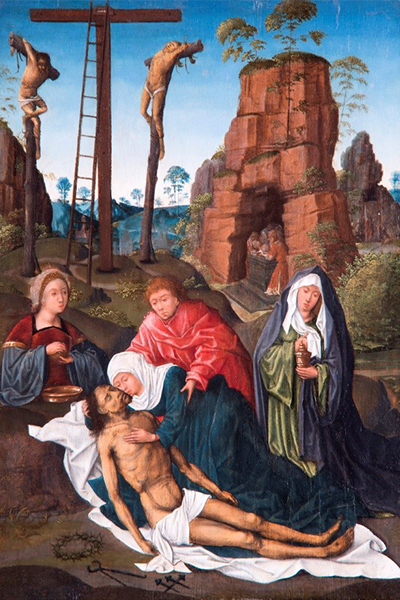La Salle University
Fifth Week of Lent Reflection
Looking at the art:

The Lamentation of Christ
16th Century
16 1/2 x 11 1/4 in. (41.9 x 28.6 cm)
Bruges School, Flemish
Object Type: PAINTINGS
Creation Place: Europe
Medium and Support: Oil on panel
Credit Line: Purchased with funds provided by the Art Angels
Accession Number: 03-P-492
Current Location: Art Museum : 15-16 C Gallery
Apart from the Crucifixion, the Lamentation is arguably the most depicted scene of the Passion narrative. Typical of the Flemish school, there are several things happening simultaneously in various vignettes of this single tableau. Of course, the focus is on Jesus taken down from the cross and attended by his mother Mary and the beloved disciple John. Traditionally Mary is clothed in blue and John in soft red. Faithful to the record in the Gospels the artist includes the other two Marys ready to bathe and anoint the body in preparation for burial.
Let us look at the composition of the tableau. Do you see groups of three? The main group is a unit composed of Jesus, his mother Mary and John, all three joined together by their arms in gestures of embrace of one another and their focus on Jesus. This main unit is situated in the center of another group which is formed with the two women on either side ready to prepare the body for burial. This triple composition in the foreground is doubled in the background by another group of three crosses: Jesus’s bare cross in the center and the two revolutionaries with their crosses on either side. Lastly another vignette, hardly discernable in the background, is the entombment of Jesus in the burial chamber belonging to Joseph of Arimathea, as recorded in the Gospels. When looked at as an ensemble, the canvas telescopes the Passion narrative in three movements: the Crucifixion, the removal from the cross and the entombment. Not to be missed are the three emblems of torture lying on the ground: the crown of thorns, the nails and the pincers used to remove them. Why three? Visually speaking, three evokes balance and symmetry. Biblically speaking, three represents harmony, completeness, and new life. By his Passion and Death Jesus reorders in harmony all good and evil, completes the prophecies of the Old Testament and by his Resurrection ushers in the hope of new life
Reflection
When I look at this picture I am immediately drawn to the interaction of Mary with her dead son. I cannot imagine what emotions go through a parent when they lose a child. It is out of the ordinary flow of what should be; parents die before their children. And this is such a cruel, painful, dehumanizing death. What could have gone through Mary’s mind and heart? This child of great promise now lies dead in her hands, tortured, and killed because of how he loved those around him. She prepares him for burial knowing that she will never look at his face again. Of all people she has the right to be angry, to cry out to heaven asking why? Why did an angel promise such hope, a savior, how is anyone being saved? If he was your son, your beloved in whom you were well pleased, why did you let this happen? If anyone had the right to ask those questions and expect an answer it was Mary.
I wonder sometimes what Jesus believed about what would happen to him after his death. He goes to his death with total trust that the God whom he loves, who has been with him all along will bring good out of his death, not simply good but redemption. If Mary is the perfect disciple, the model for all of us for how to be a follower of Jesus, then I believe that she would have accepted the death of Jesus in much the same way as Jesus accepted it himself. While there would have been the deepest sadness and pain, the broken heart of a mother, she would have believed that God was at work. She would not have had any clue of what that working would look like or what was to happen in the days ahead, and she believed that she would never see Jesus walking the earth again, but she believed, she trusted that God was at work. And while Friday night and Saturday had to be days of great sorrow, her belief allows her to experience God’s magnificent work when she sees her son alive.
In my own life do I really believe that God is at work. Can I accept what is happening, especially when it is painful or problematic, and believe that God is at work? Can I trust God to do a magnificent work in my life?